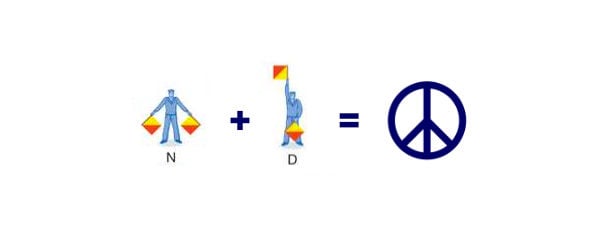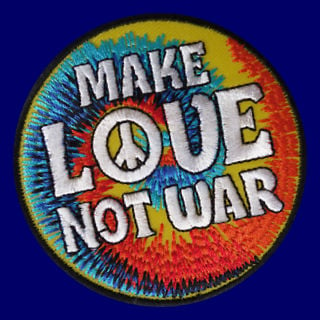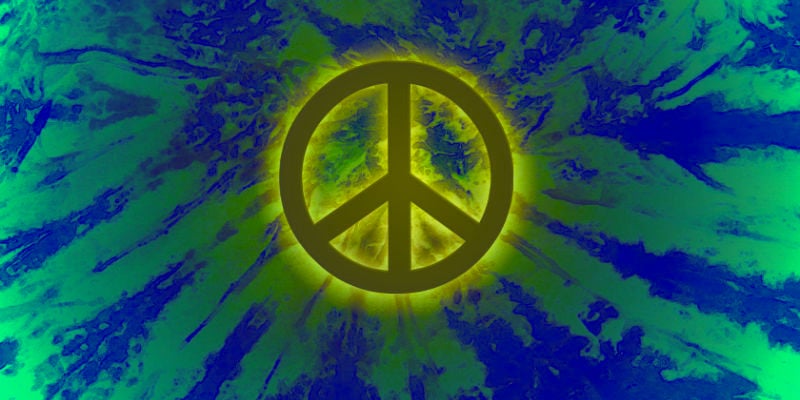Short Answer
It’s a story you’ve probably heard many times: “The international symbol for peace is based on an ancient death rune“. It’s a story so often repeated that it’s accepted as historical truth in many circles, particularly among fans of runes and rune magic.
But is the story true?
The origin of the peace symbol
The first appearance of the international symbol for “Peace” was in 1958 during a UK march for nuclear disarmament which started in London. The well known symbol consists of a circle drawn with four radii — one of which is pointed up, and the other three pointed down.

The symbol was immediately swept up by the greater movement for nuclear disarmament and emblazoned on countless flags, stickers, murals, shirts and jackets.
As the tumultuous 60’s began, the iconic symbol quickly outgrew its nuclear disarmament roots and came to represent a far broader cultural ethos. Over time, it came to represent the entire 1960’s counterculture movement, and was a favorite of hippies and protesters alike.
Who invented the peace symbol?
The international peace symbol was designed by Gerald Holtom, a professional designer and graduate of the Royal College of Art.
At the time of its creation, Holtom claimed to have created the symbol based on semaphore flag symbols. According to Holtom, the peace symbol combines the flag semaphores for “N” and “D”, standing for “Nuclear Disamament”. The symbol, said Holtom at the time, represented both semaphore positions overlaid on top of one another.

The creator of the peace symbol changes his story
The first wrinkle to the peace symbol’s origin story came in 1973, when Holtom penned a letter to the editor of Peace News. In his letter, Holtom offered up an entirely different origin story for the already world famous symbol.
Holtom’s updated, or rather entirely re-written origin story was that the symbol depicted a person with arms outstretched. This depiction, said Holtom, represented a symbol of unarmed surrender.
Holton wrote: “I drew myself: the representative of an individual in despair, with hands palm outstretched outwards and downwards in the manner of Goya’s peasant before the firing squad. I formalized the drawing into a line and put a circle round it. It was ridiculous at first and such a puny thing.”
Okay, so what happened to the semaphore thing?
Needless to say, Holtom’s changing story unfortunately casts some doubt on not only the original story, but both stories. Because Holtom’s two stories don’t match, he can no longer be considered a completely reliable source regarding the symbol’s origin — despite still being credited with the creation of the symbol. Both origin stories cannot be true.
In either case, semaphore flags or figurative representation, ancient runes were never mentioned by Holtom.
The popular definition of the peace symbol
Muddying the waters even further was the widespread and very different interpretation among the symbol’s greatest fans: Hippies.
In the late 1960’s and early 1970’s the Make Love, Not War movement swept North America during the Vietnam War. To an entire movement of counterculture stoners chanting “Make Love, Not War”, the peace symbol was a clear and rather obvious depiction of a heterosexual couple… well, getting busy.

Whether there was any legitimacy to this belief is unknown, but that doesn’t change the fact that millions of hippies who displayed the symbol thought that’s what they were communicating. The symbol seemed tailor-made to represent the first half of their slogan.
So where do runes fit in to the peace symbol story?
Here’s where the story takes yet another interesting turn.
As it turns out, British mathematician and historian Bertrand Russell had proposed a strikingly similar symbol in the 1930’s as European war-drums were increasing in tempo.
Unlike Holtom, Russell’s similar symbol was inspired by ancient runes. According to Russell, his symbol was a “rune for death” enclosed in a circle. The circle shape was often used in ancient times as a symbol for motherhood.
The combined symbols of the rune and the circle represented the death of future generations, or the ultimate cost of war.
So did Bertrand Russell invent the peace symbol?
This is where things get very cloudy. There were connections between Russel and Holtom.
In the 1950’s, the UK anti-nuclear group Campaign for Nuclear Disarmament which was headed by Bertrand Russell chose Holtom’s famous symbol to represent their march. In other words, Russell, who had previously created a very similar symbol, chose Holtom’s symbol to represent his popular movement.
Did Russell influence Holtom? Was there communication between the two parties prior to the Holtom’s creation? Did great minds just happen to think alike — and support the same movement?
We wish we knew. But interestingly, Holtom’s updated story about the symbol depicting a man with his arms down, is curiously close to the Russell’s runic origin story.
Here’s why:
What rune is inside the peace symbol?
 If indeed the peace symbol is intended to reference a rune, it would be the Algiz rune.
If indeed the peace symbol is intended to reference a rune, it would be the Algiz rune.
Although, the Algiz rune in the peace symbol would be the inverted or reversed version of the rune. (In Younger Futhark runes this inverted depiction is known as “Yr”).
According to the best divination resource on the Internet:
The rune of Algiz depicts a person with arms upraised, elk’s antlers, or a representation of the Norse God Heimdall who holds his sword in one hand and his horn in the other — guarding the divine realm of Asgard.
— iFate.com
In other words, the upright version of Algiz is a war-like aggressive posture. Conversely, the inverted Algiz symbol represents a man with arms angled-down to the sides.
In short, Algiz inverted represents a man with his guard lowered. In ancient runic inscriptions this defenseless posture may in fact mean death in some instances, or the final act of surrender. This interpretation would be in line with Russell’s description of a “rune of death”.
So does that mean Holtom came around to Russell’s runic interpretation when he updated his story?
Your guess is as good as mine. It’s certainly interesting that Holtom’s second origin story seems to match Russell’s 1930’s description of the same symbol.
Have you ever experienced a rune reading for insight and divination? Try a free rune reading here.



